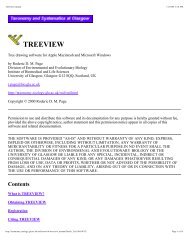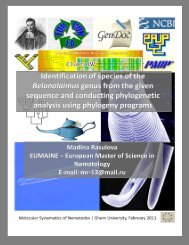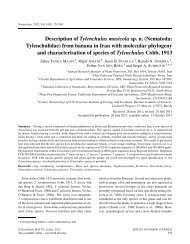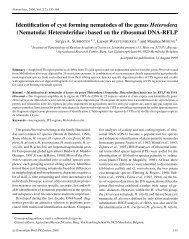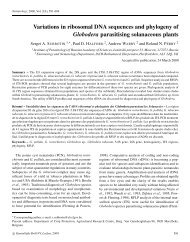Morphological and molecular characterisation of Californian species ...
Morphological and molecular characterisation of Californian species ...
Morphological and molecular characterisation of Californian species ...
You also want an ePaper? Increase the reach of your titles
YUMPU automatically turns print PDFs into web optimized ePapers that Google loves.
S. Álvarez-Ortega et al.<br />
tail”, <strong>and</strong> it was separated from Aporcelaimellus by a series<br />
<strong>of</strong> characters (see below for a detailed discussion),<br />
although the author suggested that further studies were<br />
needed to refine the definition <strong>of</strong> both genera.<br />
During nematological surveys conducted during the<br />
summer <strong>of</strong> 2011 by the two first authors in natural areas<br />
<strong>of</strong> northern California (USA), several <strong>species</strong> belonging<br />
to Metaporcelaimus were collected. The morphological<br />
<strong>and</strong> <strong>molecular</strong> study provided new data that were used to<br />
elucidate the identity <strong>and</strong> a new concept <strong>of</strong> this genus.<br />
Materials <strong>and</strong> methods<br />
NEMATODES<br />
The specimens were collected in several locations <strong>of</strong><br />
northern California. Nematodes were extracted from soil<br />
samples by sieving <strong>and</strong> sucrose-centrifugation technique<br />
(specific gravity = 1.18), somewhat modified, according<br />
to Barker (1985). The specimens were relaxed <strong>and</strong> killed<br />
by heat, fixed in 4% formaldehyde, <strong>and</strong> processed to<br />
anhydrous glycerin following Siddiqi’s (1964) method.<br />
Finally, the nematodes were mounted on permanent glass<br />
slides.<br />
LIGHT MICROSCOPY<br />
Nematodes were measured using a light microscope.<br />
Morphometrics included de Man’s indices <strong>and</strong> most <strong>of</strong><br />
the usual measurements. Some <strong>of</strong> the best preserved<br />
specimens were photographed with a Nikon Eclipse<br />
80i microscope <strong>and</strong> a Nikon DS digital camera. Raw<br />
photographs were edited using Adobe ® Photoshop ® CS.<br />
Drawings were made using a camera lucida.<br />
DNA EXTRACTION, PCRAND SEQUENCING<br />
DNA was extracted from a single individual using the<br />
proteinase K protocol. Nematode material was transferred<br />
to an Eppendorf tube containing 30 μl double distilled<br />
water, 3 μl PCR buffer (Qiagen) <strong>and</strong> 2 μl proteinase<br />
K (600 μg ml −1 ) (Promega). The tubes were incubated<br />
at 65°C (1 h) <strong>and</strong> then at 95°C (15 min). PCR <strong>and</strong> sequence<br />
protocols were as described in detail by Álvarez-<br />
Ortega et al. (2013). The primers used for amplification <strong>of</strong><br />
the D2-D3 region <strong>of</strong> 28S rDNA gene were the D2A (5 ′ -<br />
ACAAGTACCGTGAGGGAAAGTTG-3 ′ ) <strong>and</strong> the D3B<br />
(5 ′ -TCGGAAGGAACCAGCTACTA-3 ′ ) primers (Subbotin<br />
et al., 2006). The newly obtained sequences were submitted<br />
to the GenBank database under accession numbers<br />
JQ927438, JQ927439, JQ927440 <strong>and</strong> JQ927441.<br />
PHYLOGENETIC ANALYSES<br />
The newly obtained sequences were aligned with other<br />
available sequences in GenBank (Holterman et al., 2008;<br />
Pedram et al., 2011) using ClustalX 1.83 (Thompson et<br />
al., 1997). Outgroup taxa were chosen according to the results<br />
<strong>of</strong> previous published data (Holterman et al., 2008).<br />
Sequence alignments were manually edited using GenDoc<br />
2.6 (Nicholas et al., 1997). The sequence dataset was analysed<br />
with Bayesian inference (BI) using MrBayes 3.1.2<br />
(Huelsenbeck & Ronquist, 2001; Ronquist & Huelsenbeck,<br />
2003). The best fit model <strong>of</strong> DNA evolution for BI<br />
was obtained using the program MrModeltest 2.2 (Nyl<strong>and</strong>er,<br />
2002) with the Akaike Information Criterion in conjunction<br />
with PAUP* 4b10 (Sw<strong>of</strong>ford, 2003). BI analysis<br />
under the GTR + I + G model was initiated with a r<strong>and</strong>om<br />
starting tree <strong>and</strong> run with the four Metropolis-coupled<br />
Markov chain Monte Carlo (MCMC) for 10 6 generations.<br />
The topologies were used to generate a 50% majority rule<br />
consensus tree. Posterior probabilities (PP) are given on<br />
appropriate clades. The tree was visualised with the Tree-<br />
View program (Page, 2001) <strong>and</strong> drawn with Adobe Acrobat<br />
9 Pro 9.2.0.<br />
Results<br />
Metaporcelaimus capitatus<br />
(Thorne & Swanger, 1936) Andrássy, 2001<br />
(Fig. 1)<br />
MATERIAL EXAMINED<br />
Three females from only one location; in good state <strong>of</strong><br />
preservation.<br />
MEASUREMENTS<br />
See Table 1.<br />
REMARKS<br />
Two <strong>of</strong> the authors (Álvarez-Ortega & Peña-Santiago,<br />
2010a) recently re-described M. capitatus (= Aporcelaimellus<br />
capitatus) on the base <strong>of</strong> material (two females<br />
<strong>and</strong> one male, although one female <strong>and</strong> the male were in<br />
bad condition) from South Dakota, USA, originally studied<br />
by Thorne (1974). The three females herein studied<br />
2 Nematology



